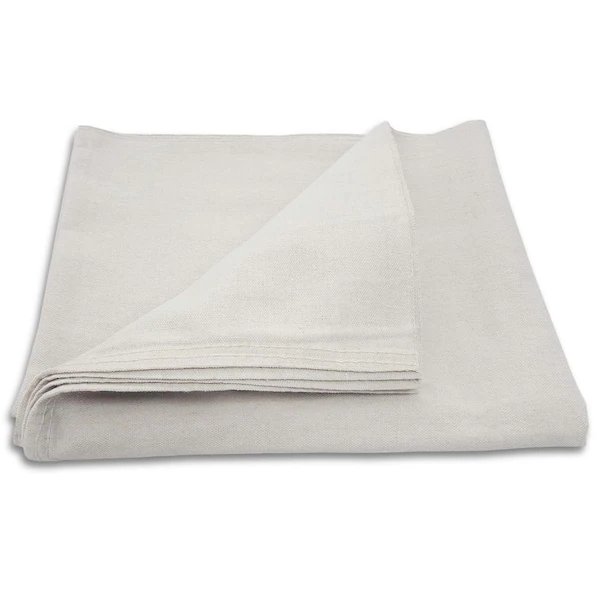Using painter drop cloths are a great way to protect furniture, walls and floors during home renovation, construction or moving projects. Follow these guidelines to get the most out of your drop cloths.
Drop cloths are an easy and effective way to protect your furniture and other things from paint and other potential hazards during a renovation project. Drop cloths can be found in various sizes, styles, materials, and pricing points. Of course, buying them in larger quantities can also save you time and money, as they are long lasting, durable and multi-purpose in use.
Among the many options for drop cloths include canvas fabrics, natural cotton, coated canvas (butyl or rubber-coated), plastic, and polyester fabrics being com. Drop cloths made of canvas fabric are the most prevalent. Drop cloths made of canvas are excellent since they can be used indoors and out, and are very reliable in terms of long term durability and reuse. For these reasons, canvas drop cloths are the most popular choice for professional painters because the canvas is easily cleaned and can be quickly repurposed for a new job. In addition, canvas fabrics are eco-friendly than other forms of drop cloths, and are often made from recycled tarp materials.
An additional benefit of butyl coated canvas drop cloths is that they are nonslip due to their rubber coating. Outdoors, butyl drop cloths are useful for covering and protecting shrubs for outdoor painting projects as well.
Plastic drop cloths offer the benefit of being lower cost than canvas fabric drop cloths, plus they’re lighter and more resistant to the elements. The most economical choice, it’s important to note that poly or plastic drop cloths are often difficult, if not impossible, to properly clean at the end of a project. Many can only be used once. Thus, due to their long lifespan, reusable canvas drop cloths are often worth the price once purchased.
If you’re facing a painting project, take comfort in knowing that the following suggestions can help you get the work done with less stress about breaking something, over-painting something or causing other forms of property damages. After all, you’re trying to complete your project in a professional manner without jeopardizing walls, floors, furniture and other hard-earned possessions. So keep the following points in mind:
? Make sure the drop cloth you order fits your requirements before placing the order. It’s important to remember that drop cloths are typically sold and supplied in their cut size, so you’ll also need to account for the size of the hem or seam you’ll need to sew. After being stitched, a piece of fabric that measures 6 feet by 7 feet before cutting may measure just 5 feet, 5 inches by 6 feet, or 7 inches. This means that a drop cloth ordered as 6′ by 7′ will measure just 6′ by 7′.
? Always use the same side of the drop cloth facing down on the furniture to prevent paint or dust from going onto the piece.
? If you want to cover the whole piece of furniture easily, it’s preferable to pick a drop cloth that’s bigger than the piece itself. Because of this, you may rest assured that the entire work is secure.
? Invest in a drop cloth in a color that complements the space it will be used in or one that you will enjoy looking at if the process takes a while.
? Canvas drop cloths are sturdy and tightly woven, making them an excellent choice for situations where more mess is likely to be made. However, canvas drop cloths are not the greatest alternative if you need to minimize taking up extra room in your storage.
? Due to their small weight, plastic drop cloths are a great option for covering heavy objects like kitchen cabinets, windows, and even large pieces of furniture. Try to keep in mind that it does not have the same absorbency as, say, canvas.
? Remember to clean the area properly before laying down a drop cloth. Because of this, you won’t have to worry about letting dirt accumulate underneath, which is especially useful for projects that will last a while.
? You can secure the drop cloth to the floor, walls, or furniture by taping it down (masking tape works well for this). Still, it would help if you thought about this for each component. It’s not a good idea to tape a plastic drop cloth directly to a kitchen cabinet; instead, you should attach it to the wall or nearby furniture so that any spills can be directed away from the cabinet. If you have a piece of furniture close to a wall, you can use tape to secure it there (bulky or light). If you’re painting the walls in a room where a drop cloth covers a couch, you can prevent paint drips from reaching the floor by taping the lowest half of the drop cloth (near the floor) to the wall.
? Paper can be used as a covering if the project is not very large or demanding of durability. Compared to, say, plastic, paper is less slippery, but it also rips more easily. Paper is not a viable option for any lengthy or intensive painting endeavor.
? Paint on the drop cloths should be given time to dry after the project. Drop cloths made of canvas or plastic should be washed in cold water, folded, and stored until they are needed again.
There you have it! We hope this guide helps you select the right canvas drop cloth for your next DIY project!
